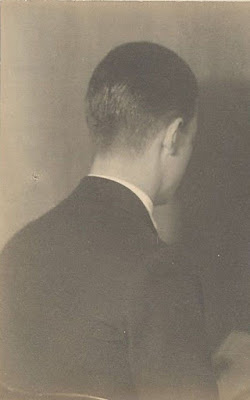
Quilt #1, a Star Medallion
Portrait of William Russell Bogart Jr.
by Man Ray
That’s a lovely story but we hope she didn’t spend her honeymoon stitching tiny diamonds together. The family tale has several flaws; the quilts do not look like they were made in the early 19th century, and Atlanta didn’t even exist until about 1837 (They may have confused Atlanta with the older Augusta.) Further fact checking might help us better date the quilts.

Quilt #2 Rectangular blocks
Both quilts look like they are pieced of silk.
Laurana (also spelled Lauranna) was born in Farmington, Connecticut some time in the late 1780s to Isaiah and Mercy Gridley Rowe.Sketch of an artist sketching Farmington by John Warner Barber
for his Connecticut history book.
Pewter plate from the family firm
Isaiah was a pewtersmith, a craftsman who worked household utensils, like a silversmith but using cheaper media like tin and pewter.
Isaiah Rowe's Family Record was filed with
a soldier's pension request---now in the National Archives.
Laurana may not have been her given name; no Laurana is on the list but she may be the second daughter here. The image is hard to read.
There he contacted Laurana's father Isaiah Rowe who had an Augusta mercantile establishment, an encounter that was probably planned. Her brother Adna S. Rowe (John must have been a cousin as Adna is a distinctive name) took over the Augusta business when Isaiah retired about 1818 and Adna and John became partners in North and Rowe of Augusta. Laurana was apparently still in Connecticut.
A biography of son John tells us a slightly different story that John senior "made his first visit to Augusta...during the progress of the war of 1812." An entrepreneur at a young age, he hauled a wagon full of Georgia cotton overland to Philadelphia, sold it and returned to Georgia with "a load of general merchandise" to set up a store.
North & Rowe logo on pewter
The rectangular blocks are hard to figure out from the small photo
but they might look like this:
Alternating two unusual patchwork designs.
Laurana gave birth to perhaps 8 children and their birthplaces tell us something of her travels. Her eldest Jane Antoinette North Richards was born about 1819 in South Carolina, somewhere east of the Savannah River (according to the 1870 census.) Two years later James Harper was born but he did not live past infancy. A second James Harper arrived two years later and lived until 1907.
The North family has several stones in New Haven's
Grove Street Cemetery in Connecticut. Laurana and her husband may
indeed be buried here but markers for her children are
cenotaphs---memorials to people buried elsewhere.
Two boys who died as infants
Philip drowned at 11 and Henry, age 39, died at Macon, Georgia
shortly after the Civil War was over.
Cold Spring is a town in Putnam County, New York
One who survived and thrived was John Adna North II, born in New York in 1831. His biography tells us: "About 1825 the family returned to New York city" as "Southern climate proved inimical to the health of the mother." North & Rowe ceased operation in 1823, probably a more accurate date for the move to New York.
Son Henry was also born in New York and may have had a twin Mary Martyn North. The Norths returned to Connecticut in the 1830s or '40s, living there for the rest of their lives. Son John grew up in New Haven and moved to Augusta when he was about 20, living there through the Civil War and leaving many Georgia descendants. Laurana's brother Adna Rowe died on a visit to Tallahassee, Florida in 1837. Her husband John died in April, 1865 in Connecticut.
The 1870 census found widowed Laurana and daughter Antoinette
living in Stratford, Connecticut. Laurana died about 5 years later.
Tracing Laurana North's homes through her children's births tells us she lived in Connecticut with some time in Augusta, Georgia about 1820 and some in New York City about 1830. Are her quilts old enough to have been stitched in Georgia or New York or are they more likely Connecticut quilts?
Without better pictures it's hard to make a guess, but they do look like the kinds of silk quilts made after 1850 and into the 1870s and '80s when silk scraps were available inexpensively. As Laurana died in 1875 we can then wonder if she was the maker. No answers but intriguing quilts.















I'm guessing you did more genealogy on this family than the grandchildren! I wonder how long it took to do all those diamonds?!
ReplyDelete